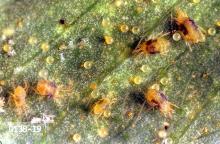Tetranychus urticae
Pest description and crop damage Tiny, spiderlike animals found on the underside of foliage and on plant terminals. Spider mites become a problem when air temperatures begin increasing in the summer. Dry, dusty conditions favor these pests. Mites feed on leaf surfaces. Yellowing and bronzing on the top side of the leaves indicates the presence of mite colonies on the underside. Lots of webbing and leaf desiccation indicate severe mite infestation.
Scouting and thresholds Sampling for mites requires close visual inspection. Shake plants over a white pail and look for tiny moving dots. A 10x hand lens helps. Mite populations can increase rapidly, so it is important to scout frequently.
Management-chemical control
- etoxazole (Zeal) at 2.0 to 3.0 oz/A (0.09 to 0.135 lb ai/A). REI 12 hr. The best results are achieved when mite populations are low. The product is predominantly an ovicide/larvicide and should be used early in the life cycle of mites. Do not make more than one application per season. Extremely toxic to aquatic invertebrates. Avoid drift and runoff to fish-bearing bodies of water. Ground application only. Do not apply through any type of irrigation system. No portion of treated plants can be used for food or feed. 24c SLNs: (Washington only) WA-090001 (expires 12/21/28).
- hexythiazox (Onager Optek)-See SLN label for rates. REI 12 hr. Apply prior to adult mite buildup, this product does not control adult mites. No application by air. Do not apply through any type of irrigation system. Do not apply more than once per year. Rotation crop restrictions. This pesticide is toxic to fish and aquatic invertebrates. Do not use the product where impact on listed threatened or endangered species is likely. No portion of treated plants can be used for food or feed. 24c SLN: Onager Optek (Oregon and Washington only) OR-190009 (expires 12/31/25), WA-170013 (expires 12/31/26).
- propargite (Comite) at 2 to 3 pints/A or 32 to 48 fl oz/A (1.6 to 2.5 lb ai/A). REI 2 days. Hand harvest prohibited for 13 days in Idaho and Oregon. Start applications as soon as mites appear. Complete coverage is necessary for effective control. Allow at least 14 days between applications. Do not make more than two applications per season. Do not apply through any type of irrigation system. This pesticide is toxic to fish and aquatic invertebrates and may cause reproductive effects in wildlife. Do not apply directly to water or areas where surface water is present. Do not apply by ground equipment within 50 feet or by aerial equipment within 75 feet of bodies of water. Hand harvest of carrots is prohibited for 13 days after application. Rotation crop restrictions. No portion of treated plants can be used for food or feed. 24c SLNs: (Washington only) WA-040019 (expires 12/31/25).
- spiromesifen (Oberon 4SC) at 4.0 to 8.0 fl oz/A (0.125 to 0.25 lb ai/A). REI 12 hr. PHI 7 days. Do not apply during crop flowering. Apply by ground or by air. Chemigation is allowed in Washington. Start application at the onset of infestation. Allow at least 7 days between applications. Do not exceed 16 fl oz/A per season. This product is toxic to fish and aquatic invertebrates. Do not contaminate surface water. No portion of treated plants can be used for food or feed. 24c SLNs: (Oregon and Washington only) OR-160014 (expires 12/31/26), WA-190004 (expires 12/31/28).


